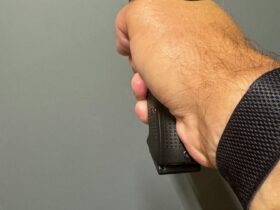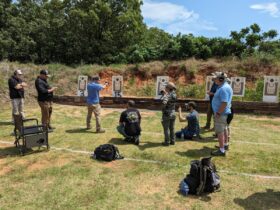Having recently talked about grip, the next logical thing to talk about is working the trigger. I use a “trigger continuum” where I do the same thing with my finger for any shot, but the speed and pressure that I apply to the trigger change as needed. This is also where the press out comes in and really shines.
Most shooters that I deal with have problems consistently hitting what they are aiming at. Some of that is anticipation of the shot, and we will look at that another time. The other part is a misunderstanding of trigger control. Or rather, a lack of a system that gives them the consistency they need.
For a difficult shot with no time limit, pressing the trigger straight to the rear while slowly adding pressure can work pretty well. If it takes 5 seconds or 15 seconds, it doesn’t really matter for our purposes here. Unfortunately, very few shots will ever allow you to take 15 seconds to pull the trigger, so we usually need to speed things up a bit. A solid grip on the gun, combined with increasing pressure on the trigger will make the gun go off pretty close to where you are holding. The faster you need to break the shot, the more pressure you apply to the trigger. If the 5-15 second trigger press is one extreme, the other extreme is needing to make the shot NOW!
If your gun is already at extension for some reason, smashing on the trigger, that is, taking up all the travel of the trigger and making the shot as fast as you can move your finger, can work very well. A solid grip and a large enough target are what’s needed to start with, but with practice, you can accomplish this on many realistic targets, range-dependant.
If your gun is not at extension but rather is in some form of compressed ready or still in the holster, then as you push the gun toward your normal shooting position, you can take up any slack the trigger has and start to put pressure on the sear. How much pressure and how aggressive you can be depends on the particular gun you are using. A double-action trigger can be handled pretty aggressively. A single action trigger is usually treated a little more circumspectly, as you might imagine. We call this the press out, and one of its biggest benefits is taking care of much of the trigger pull before the gun gets to extension. This minimizes the chances of disturbing the shot since less force is needed at the moment the sear releases.
I don’t need to see my sights while extending my pistol in order to use the pressout, but I do want my pistol to be pointed at the target. The goal is for the shot to break just as the pistol gets to its final firing position, much like a runner sliding into home. While practicing the press out, you will occasionally fire the shot slightly before you reach your normal shooting position. Most people find that this results in a very accurate shot, as no anticipation can interfere. Once you get past the beginning stages of learning the pressout it is rare to have an early shot go off, but it can still happen. As long as the gun is pointed at the target, all is well.
Of course, you would never put your finger on the trigger if you don’t want to make a loud noise and a hole, so the press out is only for those times when you have already decided to shoot, and you need to make that happen expeditiously.
For every shot that falls somewhere between extreme urgency and no time limit, I adjust my pressure on the trigger accordingly. This model allows me to have one trigger press, adjusted for circumstances as need be. Regardless of how fast the pressure is applied, I reset the trigger in recoil and am waiting for whatever level of visual confirmation I might need for the next shot. I am never waiting on the trigger since the reset happens very fast and while the gun is off line of the target.
There are of course some nuances to all this, but what I have laid out is my basic approach to trigger manipulation. I find it simple to do and simple to teach, and it covers my needs well.




Leave a Reply